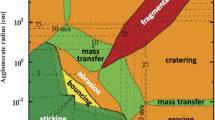Abstract
Some mechanisms which are expected to produce the growth of dust grains in the protosolar nebula are studied during the isothermal and the adiabatic phase of the gravitational collapse.
Owing to the low sticking efficiency in the grain-grain collisions and also to the impossibility of gas capture by solid particles in the physical environment considered, the main result is the production in about 106 yr of a set of particles similar in mass. The obtained mass limit (10−8–10−9 g) depends on the physical properties of the grains, and seems to be independent of the turbulence model used for the gas motion.
Similar content being viewed by others
References
Augason, G. C.: 1970,Astrophys. J. 162, 463.
Cameron, A. G. W.: 1973,Icarus 18, 407.
Carusi, A., Coradini, A., Federico, C., Fulchignoni, M., and Magni, G.: 1974, in A. Woszczyk and C. Iwaniszewska (eds.), ‘Exploration of the Planetary System’,IAU Symp. 65, 21.
Carusi, A., Coradini, A., Federico, C., Fulchignoni, M., and Magni, G.: 1975,Astrophys. Space Sci. 33, 369.
Goldreich, J. M. and Ward, W. R.: 1973,Astrophys. J. 183, 1051.
Greenberg, J. M.: 1971,Astron. Astrophys. 12, 240.
Kurt, V. G. and Sunayev, R. A.: 1968,JETP (Letters) 7, 164.
Kusaka, T., Nakano, T., and Hayashi, C.: 1970,Progress of Theoretical Physics 44, 1580.
Larson, R. B.: 1973,Fundamentals of Cosmic Physics 1, 1.
Reeves, H.: 1972,Symp. on the Origin of the Solar System, CNRS, Nice, p. 89.
Reeves, H.: 1975,La Recherche 6, 808.
Solomon, P. M. and Wickramasinghe, N. C.: 1969,Astrophys. J. 158, 449.
Wickramasinghe, N. C. and Reddish, V. C.: 1968,Nature 218, 661.
Willis, R. F. and Fitton, B.: 1975,Astrophys. Space Sci. 34, 57.
Author information
Authors and Affiliations
Rights and permissions
About this article
Cite this article
Coradini, A., Magni, G. & Federico, C. Grains accretion processes in a proto-planetary nebula. Astrophys Space Sci 48, 79–87 (1977). https://doi.org/10.1007/BF00643041
Received:
Issue Date:
DOI: https://doi.org/10.1007/BF00643041




